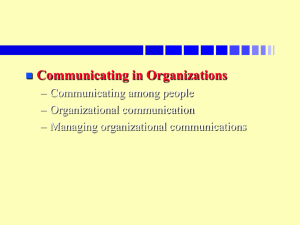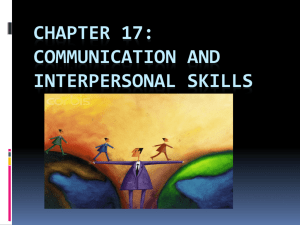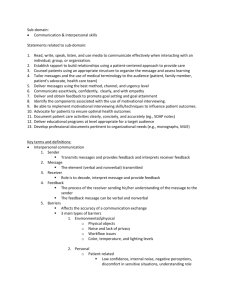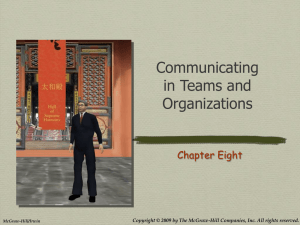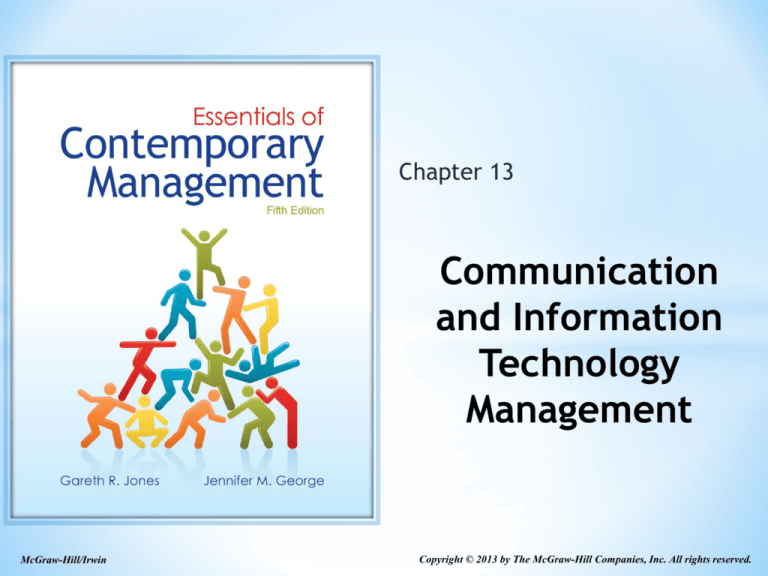
Chapter 13
Communication
and Information
Technology
Management
McGraw-Hill/Irwin
Copyright © 2013 by The McGraw-Hill Companies, Inc. All rights reserved.
Information and the Manager’s Job
• Managers cannot plan, organize, lead, and control
effectively unless they have access to information.
• Data: Raw, unsummarized, and unanalyzed facts
that by themselves, does not tell managers
anything.
• Information is the source of the knowledge and
intelligence they need to make the right decisions.
• One of the uses of information technology is to help
managers transform data into information in order to
make better decisions.
13-4
Four factors Affecting the Usefulness of
Information
13-5
• Quality: The greater its level of accuracy and
reliability, the higher is the quality of information.
•
a. For IT to work well, the information it provides
must be of high quality---it must be timely,
complete, and relevant.
• Timeliness: Timely information is available when it
is needed, not after the decision has been made.
•
a. In today’s rapidly changing world, information
must be available on a real-time basis.
• b. Real-time information is information that
reflects current conditions.
13-6
• Completeness: Information that is complete gives
managers all that they need to know to exercise
control, achieve coordination, or make an effective
decision.
•
a. One of the functions of IT is to increase the
completeness of the information that managers have
• Relevance: Information that is relevant is useful and
suits a manager’s particular needs and circumstances.
•
a. Irrelevant information is useless and may actually hurt
the performance of a busy manager.
• b. The people who design IT must make sure that
managers receive only relevant information.
13-7
What is Information Technology?
• Information technology: The set of methods or
techniques for acquiring, organizing, storing,
manipulating, and transmitting information
• An information system is a system for acquiring,
organizing, storing, manipulating, and transmitting
information.
• Management information system(MIS): A specific
form of IT that managers utilize to generate the
specific, detailed information they need to perform
their roles effectively
13-8
• As long as there have been organizations, information
systems have existed. Before the computer age, most
information systems were paper based.
• The rapid advances in the power of information
technology are critical to organizations.
•
•
a. Those organizations that have not adopted new IT, or
have done so ineffectively, cannot remain competitive
with those that do.
Managers need information for three reasons: to make
effective decisions, to control the activities of the
organization, and to coordinate the organization’s
activities.
13-9
Information and Decisions
• Most of management is about making decisions
• To make effective decisions, managers need
information both from inside the organization and
from external stakeholders
• Managers’ ability to make effective decisions rests
on their ability to acquire and process information.
13-11
Information and Control
• Controlling is the process whereby managers regulate
how efficiently and effectively an organization is
performing the activities necessary to achieve
organizational goals.
• Managers achieve control over organizational activities
by taking four steps:
•
a. They establish measurable standards of performance
or goals.
• b. They measure actual performance.
• c. They compare actual performance against established
goals.
• d. They evaluate the result and take corrective action if
necessary.
13-12
Information and Coordination
• Coordinating department and divisional activities
to achieve organizational goals is another basic
task of management
• To deal with global coordination problems,
managers have been adopting sophisticated
computer-based information systems
13-13
Communication, Information and
Management
• Communication: The sharing of information
between two or more individuals or groups to reach
a common understanding
• Communication, including that which is
electronically based, is a human endeavor and
involves individuals and groups.
• Communication does not take place unless a
common understanding is reached.
13-14
Importance of Good Communication
• Because good communication is essential for obtaining
efficiency, quality, responsiveness to customers, and
innovation, it is a necessity for gaining a competitive
advantage.
• Good communication is necessary so that managers can
increase efficiency by learning to take advantage of
new and more efficient technologies and by training
workers to operate the new technologies.
• Improving quality hinges on effective communication,
since managers need to communicate to employees the
importance of high quality and the ways of attaining it.
13-15
Importance of Good Communication
• Good communication can help increase responsiveness
to customers.
• When the organizational members who are closest to
customers are empowered to communicate customer
needs to managers, managers are better able to respond
to these needs.
• Innovation, which often takes place in cross-functional
teams, also requires effective communication.
• Team members must effectively communicate with each
other to develop high quality products that customers
want and the organization can produce efficiently.
13-16
Perception
The process by which individuals attend to,
organize, interpret, and retain information
from their environments.
Perception Filters
1.1
The personality-, psychology-, or
experienced-based differences that
influence people to ignore or pay attention
to particular stimuli. People exposed to
the same information will often disagree
17
about what they saw or
heard.
Stimulus
1.1
Stimulus
Stimulus
Perceptual
Attention
Filter
Perceptual
Organization
Filter
Perceptual
Interpretation
Filter
Perceptual
Retention
Filter
18
•Attention-the process of noticing
particular stimuli.
•Organization-the process of
incorporating new information into your
existing knowledge.
•Interpretation-the process of attaching
meaning to new knowledge.
•Retention-the process of remembering
interpreted information.
Perceptual Challenges:
What Do You See?
Copyright © 2005
Prentice Hall, Inc. All
rights reserved.
Exhibit 8.5
8–20
• Personal
characteristics
• Target characteristics
• Characteristics of the target
• Attitudes
• Personality
• Motives
• Interests
• Past experiences
• Expectations
Copyright © 2005
Prentice Hall, Inc. All
rights reserved.
and its relationship to its
background.
• Contextual elements, such
as time, location, light, or
heat.
8–21
• At work, we are constantly bombarded with sensory stimuli—
the phone ringing, people talking in the background, the
sounds of our computers dinging as new e-mail arrives,
people calling our names, etc.
• We cannot possibly notice, receive, and interpret all of this
information.
• As a result, we attend to and accept some stimuli but screen
out and reject others.
• Selective perception
• notice and accept stimuli which are consistent with our values and
beliefs
• ignore inconsistent stimuli
• Closure
1.2
• tendency to fill in the gaps when information is missing
• we assume that what we don’t22 know is consistent with what we do
know
Perception of Others
• Attribution Theory
• we have a need to understand and explain the causes of
other people’s behavior; we need to know why people do
what they do).
• General reasons to explain behavior
• Internal attribution
• the behavior was voluntary or under their control
• External attribution
• the behavior was involuntary and beyond their control
1.3
23
1.3
Defensive
Bias
The tendency for people to
perceive themselves as personally and
situationally similar to someone who is
having difficulty. We tend to use external
attributions to explain behavior.
Fundamental
Attribution
Error
The tendency to ignore external causes
of behavior and to attribute other
people’s actions to internal causes.
Which attribution, the defensive bias or the fundamental attribution
error, are workers likely to make when something goes wrong?
24
1.3
25
Self-Serving Bias
The tendency to overestimate our value by
attributing successes to ourselves (internal
causes) and attributing failures to others or
the environment (external causes).
1.4
The self-serving bias can make it especially difficult
for managers to talk to employees about
performance problems.
26
The Communication Process
13-27
The Communication Process
• The communication process consists of two phases.
•
a. In the transmission phase, information is shared
between two or more individuals or groups.
•
b. In the feedback phase, a common understanding
is reached.
• To start the transmission state, the sender, the
person or group wishing to share information with
some other person, decides on the message, and
what information to communicate.
13-28
The Communication Process
• The sender translates the message into symbols or
language, a process called encoding.
• Noise refers to anything that hampers any stage of
the communication process.
• Once encoded, a message is transmitted through a
medium to the receiver, the person or group for
which the message is intended.
•
A medium is the pathway through which a
message is transmitted to a receiver.
13-29
The Communication Process
• At the next stage, the receiver interprets and tries to
make sense of the message, a process called decoding.
• The feedback phase is begun when the receiver decides
what message to send to the original sender, encodes
it, and transmits it.
• The original sender decodes the message and makes
sure that a common understanding has been reached.
• If a common understanding has not been reached, the
sender and receiver repeat this process as times as
needed to reach a common understanding.
13-30
The Communication Process
• Verbal communication: The encoding of messages into
words, either written or spoken
• Nonverbal communication: The encoding of messages
by means of facial expressions, body language, and
styles of dress
• Nonverbal communication can be used to reinforce verbal
communication.
• People tend to have less control over nonverbal
communication and can inadvertently send a message
they did not intend to.
• Sometimes nonverbal communication is used to send
messages that cannot be sent through verbal channels.
13-32
The Dangers of Ineffective
Communication
• Because managers must communicate with others
to perform their various roles and tasks, they
devote a lot of time to this activity.
• When managers and other members of an
organization are ineffective communicators,
organizational performance suffers, and any
competitive advantage the organization might have
is likely to be lost
• Poor communication sometimes can be downright
dangerous and even lead to tragic and unnecessary
loss of human life
13-33
Information Richness and Communication
Media
• To be effective communicators, managers need to select an
appropriate communication medium for each message they
send.
• There is no one best communication medium for managers to
rely upon.
• When choosing a communication medium, managers should
consider three factors.
• Information richness: The amount of information that a
communication medium can carry and the extent to which the
medium enables the sender and receiver to reach a common
understanding
• The second factor is the amount of time needed for
communication.
• The third factor is the need for a paper or electronic trail to serve
as evidence that a document was sent or received.
13-34
The Information Richness of
Communication Media
13-35
Information Richness and Communication
Media
• Face-to-face communication
• Has highest information richness
• Can take advantage of verbal communication and
nonverbal signals
• Provides for instant feedback
• Management by wandering around: A face-to-face
communication technique in which a manager walks
around a work area and talks informally with
employees about issues and concerns
• Face-to-face communication should not always be the
medium of choice for managers because of the large
amount of time it consumes and the lack of a paper or
electronic trail.
13-36
Information Richness and Communication
Media
• Spoken communication electronically transmitted:
• Has the second highest information richness
• Telephone conversations are information rich with
tone of voice, sender’s emphasis, and quick feedback
- but provide no visual nonverbal cues
• Managers also can get quick feedback over the
telephone and answer questions, thereby ensuring
that a mutual understanding is reached.
• Voice mail systems also allow managers to send and
receive verbal electronic messages.
13-37
Information Richness and Communication
Media
• Personally addressed written communication:
• Has a lower richness than the verbal forms of
communication - but still is directed at a given person
• Excellent media for complex messages requesting followup actions by receiver
• Because personally addressed written communication is
addressed to a specific person, there is a good chance
that the person will open and read it. Also, the sender
can write the message in a way that the receiver is
most likely to understand.
• Even if managers use face-to-face communication, a
follow-up in writing is often needed.
13-38
Information Richness and Communication
Media
• E-mail also fits into this category because senders and
receivers are communicating through personally addressed
written words. It is important to follow e-mail etiquette.
• The widespread use of e-mail has been accompanied by its
growing abuse.
•
To avoid e-mail abuse, managers need to develop a clear
policy specifying what company e-mail should be used for and
what is out of bounds.
• Managers also should clearly communicate this policy to all
members of an organization.
• Employees should also be informed of procedures that will be
used when e-mail abuse is suspected and the consequences
that will result when e-mail abuse is confirmed.
13-39
Information Richness and Communication
Media
• Impersonal written communication:
• Has the lowest information richness.
• Good for messages to many receivers where little or
feedback is expected (e.g., newsletters, reports)
• Information overload: A superabundance of
information that increases the likelihood that
important information is ignored or overlooked and
tangential information receives attention
13-40
Advances in Information Technology
• Product life cycle: The way demand for a product
changes in a predictable pattern over time
13-41
Figure 13.4 - A Product Life Cycle
13-42
Figure 13.5 - A Four-Tier Information System
with Cloud Computing
13-43
Figure 13.6 - Four Computer-Based
Management Information Systems
13-44
The Organizational Hierarchy: The
Traditional Information System
• Traditionally, managers have used the
organizational hierarchy as the main system for
gathering information necessary to make decisions
and coordinate and control activities
13-45
The Organizational Hierarchy: The
Traditional Information System
• Several drawbacks
• Can take a long time for information to travel up the
hierarchy and for decisions to travel back down
• Information distortion: Changes in meaning that
occur as information passes through a series of
senders and receivers
• As an organization grows larger, its hierarchy
lengthens and this tall structure can make the
hierarchy a very expensive information system
13-46
Limitations of Information Systems
• A vital human element of communication may be
lost
• Very rich information is required to coordinate and
control an enterprise and to make informed
decisions, far beyond that which can be quantified
and aggregated
• The importance of information richness is a strong
argument in favor of using electronic
communication to support face-to-face
communication, not to replace it
13-47
Question
Which of the following management information
systems gathers, organizes, and summarizes
comprehensive data in a form that managers can
use in their nonroutine coordinating, controlling,
and decision-making tasks?
A. Transaction-processing system
B. Operations information system
C.Decision support system
D.Expert system
13-48

